November 1, 2019
Air Date: November 1, 2019
FULL SHOW
SEGMENTS
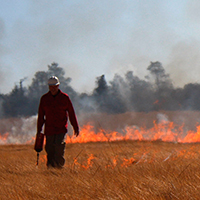
Fighting Fire with Prescribed Fire
View the page for this story
A century of fire suppression has turned much of the West into a tinderbox. Prescribed fire could help bring nature back in balance, but it’s currently far more common in the Southeast than in the West, where it’s sorely needed, says Pyrogeographer Crystal Kolden of the University of Idaho. She joins Host Steve Curwood to talk about the opportunities to get communities involved in prescribed burns, and the challenges of building fire-resilient communities. (09:59)

Beyond the Headlines
/ Peter DykstraView the page for this story
Peter Dykstra and Host Bobby Bascomb take a trip beyond the headlines to acknowledge the growing popularity of plant-based meat alternatives like the Impossible Burger. Then, they discuss the ongoing Keystone XL pipeline protests. Finally, the two look at the anniversary of the Atlantic Striped Bass Conservation Act of 1984. (03:58)
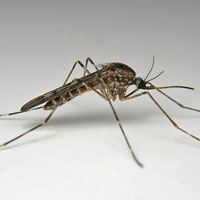
Note on Emerging Science: Deforestation and Malaria
/ Don LymanView the page for this story
Rainforests are a crucial ecosystem when it comes to fostering biodiversity, providing carbon sequestration, and even protecting human health. Researchers recently found that a 10% increase in deforestation in the world's rainforest is linked with a 3.3% increase in the number of malaria cases worldwide. Living on Earth's Don Lyman reports. (01:34)
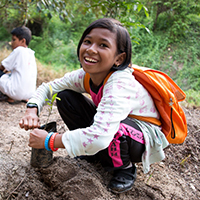
Healthy People Equal Healthy Forests
View the page for this story
Gunung Palung National Park on the island of Borneo is home to diverse species found nowhere else, and beloved by the people who live on the Indonesian island. But like many people who live near tropical forests, they have at times had to resort to illegal logging to pay for healthcare. Now the nonprofit Health in Harmony is providing healthcare that patients can pay for with a simple trade of labor, seedlings or manure, so that no one ever has to log to pay cash for essential health services. Founder Kinari Webb and Host Bobby Bascomb discuss the importance of listening to what forest communities say they need in order to stop logging. (15:12)
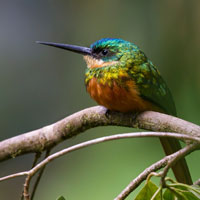
BirdNote®: Green Birds and Brown Birds in the Tropical Rainforest
/ Michael SteinView the page for this story
The tropical rainforests of the world are lush habitats home to thousands of different species, and their birds have evolved a tremendous variety of adaptations, from intricate courtship rituals to massive horned bills for cracking nuts. But as BirdNote’s Michael Stein reports, most rainforests birds do have at least one thing in common: their plumage. (02:12)
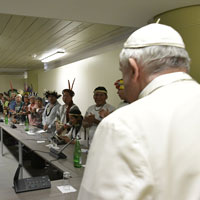
Pope Hosts Amazon Synod
View the page for this story
Pope Francis recently called the bishops of the Amazon to Rome for a synod to bring them together with lay members of the indigenous community to address human rights, climate change and deforestation. And there is such an acute shortage of priests in Latin America, the synod ended up calling for allowing priests to marry and the ordination of women as deacons to have a more effective response to the Amazon crisis. Father Thomas Reese, author of Inside the Vatican, joins Host Steve Curwood to discuss. (12:40)
Show Credits and Funders
Show Transcript
HOSTS: Bobby Bascomb, Steve Curwood
GUESTS: Crystal Kolden, Father Thomas Reese, Kinari Webb
REPORTERS: Peter Dykstra, Don Lyman, Michael Stein
[THEME]
CURWOOD: From Public Radio International – this is Living On Earth.
[THEME]
CURWOOD: I’m Steve Curwood.
BASCOMB: And I’m Bobby Bascomb
Catholic Bishops and indigenous leaders from the Amazon travel to Rome for an assembly with the Pope to discuss deforestation.
REESE: These bishops are from the Amazon region itself so they're talking about personal experience, they've seen the destruction of the Amazon forest and they've seen the killing of their people who have stood up for their rights.
CURWOOD: Also, an innovative way to conserve the rainforest of Borneo – make healthcare affordable for would be loggers.
WEBB: We don't want anyone to ever have to log to pay for healthcare. So they can pay with labor; they can pay with manure, actually, that we use for the organic farming training; they can pay with seedlings. Last year we collected 18,000 seedlings from patients.
CURWOOD: We’ll have those stories and more this week on Living on Earth – Stick Around!
[NEWSBREAK MUSIC: Boards Of Canada “Zoetrope” from “In A Beautiful Place Out In The Country” (Warp Records 2000)]
Fighting Fire with Prescribed Fire
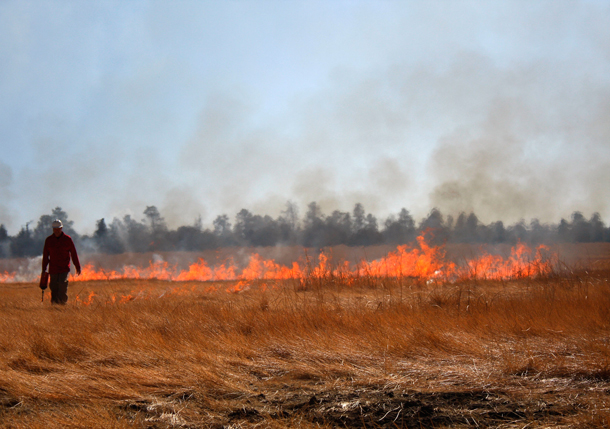
A firefighter uses a drip torch as part of a prescribed burn in the Coconino National Forest, Arizona. (Photo: Ian Horvath / Coconino National Forest, Flickr CC BY-SA 2.0)
[THEME]
BASCOMB: From PRI and the Jennifer and Ted Stanley Studios at the University of Massachusetts Boston, this is Living on Earth. I’m Bobby Bascomb.
CURWOOD: And I’m Steve Curwood. The huge wildfires in California and Baja California have their roots in little things, an abundance of underbrush where a single spark can ignite a whole forest. Fires can be beneficial for forests, as long as they happen often enough to clear tinder that can feed a firestorm, and Nature has managed forests forever that way with lightning. For people, one proven way of preventing wildfires is the use of prescribed fire, not unlike what native Americans historically did to manage the landscape and attract game. But prescribed burns are barely used at all in California, where hundreds of thousands of people have had to evacuate their homes in recent weeks as perfect conditions fuel the Kincade and other fires. Meanwhile in the Southeastern United States prescribed fire is relatively common. In fact, 70% of all prescribed burns in the US take place in the Southeast each year, compared to just over 2% in California, according to a paper published in the journal Fire in May of 2019. To find out why, we’ve got lead author Crystal Kolden on the line. She’s a Pyrogeographer at the University of Idaho. Welcome!
KOLDEN: Thanks so much for having me, Steve.
CURWOOD: Tell us, what exactly burns in a prescribed fire, and what doesn't?
KOLDEN: Prescribed fires are usually used to reduce a lot of the understory vegetation in a forested system, things like the grasses and the shrubs and some of the low plants and even some of the seedlings and saplings, those little baby trees that are growing in the understory. And so they reduce a lot of that, they combust it. They also combust a lot of the dead woody material on the forest floor, old dead trees that have fallen down or just limbs that have fallen off trees, all those things that could burn in a wildfire. If we're doing prescribed fires to reduce wildfire risk, that little stuff seems really harmless but that's what carries a fire and allows it to really start building energy and get up into the crowns of the trees. And where we're doing prescribed fire for forest health, we're actually trying to remove a lot of those competitors and allow the big trees to soak up more water and more nutrients and grow even bigger and healthier.
CURWOOD: And of course, the bigger the tree is, the more carbon it takes out of the atmosphere.
KOLDEN: That's correct. And, and that is another reason that people are starting to use prescribed fire, not necessarily as the primary use, but where there was historically a lot of fire, reintroducing fire through prescribed fire into these systems actually helps those big trees grow bigger like they used to be, and it helps sequester a lot more carbon.
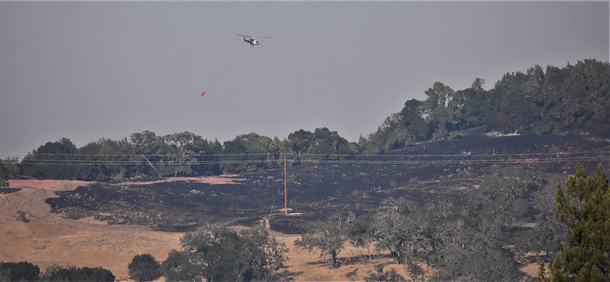
CAL FIRE helicopters drop water on hilltops in Sonoma County threatened by the Kincade fire, Oct. 28, 2019. (Photo: California National Guard, Flickr CC BY 2.0)
CURWOOD: And I gather that, particularly in the West where we're seeing such devastating wildfires, for the longest time the ethos of Smokey the Bear, that is prevent a forest fire, kept all this little stuff from getting burned naturally.
KOLDEN: That's very true. And the suppression mantra in the US and particularly in the western US really gained lot of momentum during the 40s. And there was sort of a bunch of things that happened all at the same time. One, there were some really large fires in the western US that took out a lot of valuable timber because of course, there weren't that many people living in the West in the earlier part of the 20th century. But that loss of these valuable timber forests really promoted this idea that we need to suppress all these fires so that we can save this valuable timber, so that we don't burn into these communities that are starting to grow in the West. And that's where we get Bambi from; Bambi was released in 1942, and there's very much this anti-fire message in Bambi. Smokey Bear comes from that same era. And if you look at a lot of the historical materials around World War II, there was also this link drawn between the Axes, particularly the Germans and the Japanese, right, and forest fires, because there was this message sent out by the US government that if you set forest fires, you're actually helping the enemy. So there was this strong message that was built around trying to suppress fires during this era, and that was very American at the time, to suppress those fires.
CURWOOD: Oh my goodness. So, unpatriotic; you know, Bambi, a bare-chested bear; and helping the war effort. Oh, my.
KOLDEN: Yes. [LAUGHS]
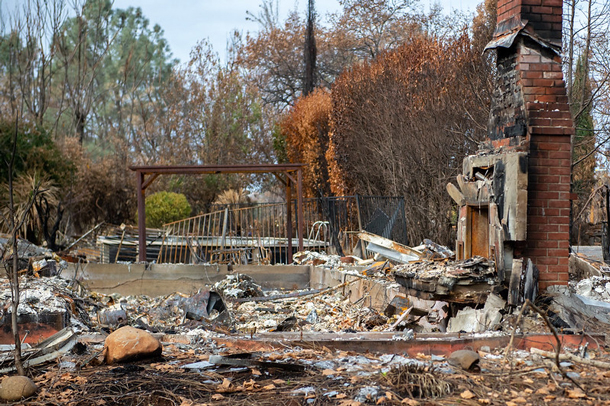
A destroyed home in the aftermath of the Camp Fire that swept through Paradise, California in November 2018. Prescribed burns can reduce the risk of wildfire to communities. (Photo: California Governor’s Office of Emergency Services, Flickr CC BY-NC 2.0)
CURWOOD: So why are prescribed burns so much more common in the southeast part of the US than the West, where it seems like they are really needed?
KOLDEN: So the southeastern US has a very different history and land use legacy than the western US does, as well as a very different climate. And the southeastern US has been using a lot of prescribed fire for almost 100 years. They really started to build prescribed fire programs in the Southeast in the 20s and 30s. And the reason for that was actually kind of an interesting one. They were seeing that a lot of the game species that hunters wanted to hunt during that time, predominantly upland bird species, they were seeing those disappear. And there were several biologists and wildlife ecologists that thought to themselves, well, I wonder if fire could actually help restore the habitats of these critters. And in fact, it did. And so there was this evolution away from the suppression mindset, and towards this idea that fire can actually be really beneficial. Beneficial for the game species that they like to hunt, but also beneficial for the forests that form an economic component in the Southeast, these long leaf pine forests. And today, the Southeast burns about 5 million acres a year. It's just a huge burning program, and they do just over 70% of prescribed fire in the US.
CURWOOD: Now, earlier this year, we had a segment in our broadcast about neighborhood burn squad communities in California, that are taking prescribed fire into their own hands and actually doing it themselves, with the advice of some experts. How safe is this, do you think?
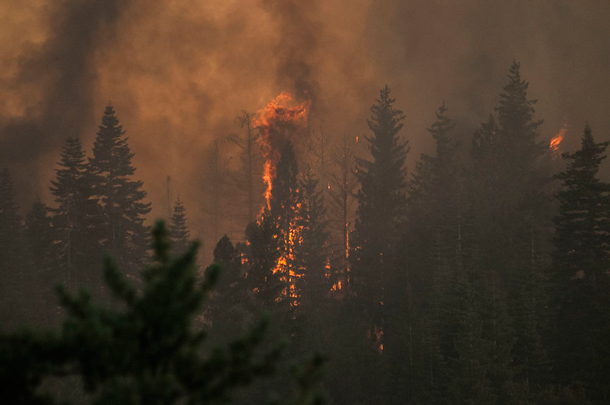
Prescribed fire is often intended to remove the small woody debris and vegetation that a wildfire could use to climb up into the crowns of trees. (Photo: California Governor’s Office of Emergency Services, Flickr CC BY-NC 2.0)
KOLDEN: I think that the risk factor is going to really depend on how this gets implemented. And these sort of neighborhood burn squads, these are becoming more prevalent, particularly in places like California, in the aftermath of a state bill that was passed last year called state Bill 1260, which is meant specifically to try and increase the amount of prescribed fire in the state. And that bill also charges the state fire agency, called Cal Fire, with developing an educational curriculum so they actually start to train citizens on how to do prescribed fire a little bit more safely. And it also sets up a permitting program. So when we talk about neighborhood burn squads, people are not going out and just doing this willy-nilly, with no permission, right. They are still getting burn permits. And so in California now, they have to get this training on prescribed fire before they can get the permit to go out and do this. And that is meant to try and reduce some of the risk with this. Is there still going to be risk? Absolutely. But one of the things that I am really interested in studying and watching how this develops is that in places like California, there's an enormous amount of private land in the state. It's about 45% private land. And what that means is that federal fire managers, the sort of trained professionals, right, they can only do prescribed fire on federal lands. And so there's a lot of land that could benefit from prescribed fire, but won't get it from the federal fire professionals, because it's not their jurisdiction, and because they simply don't have enough people and enough resources to do it.
CURWOOD: Crystal, let's talk about end game in the face of a wildfire, that is, the buildings that get caught up by this. Some of these survive and some don't. To what extent is it possible to build homes that are relatively fireproof?
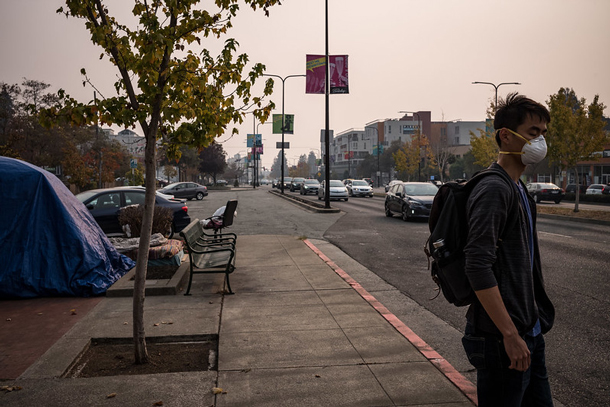
Wildfire smoke is harmful to human health. Smoke from prescribed fire can be a concern, too, but because of the lower fire temperatures it contains fewer harmful particulates, and residents are notified of upcoming prescribed burns so they can prepare. (Photo: Bastian Greshake Tzovaras, Flickr CC BY-SA 2.0)
KOLDEN: So trying to build houses that are relatively fireproof has been a challenge for a long time. And what we see in communities that are impacted by fires, for example, the fires happening right now in California, is that these houses were built during an era when there was not as much fire, so they were not built to be less flammable. What they were built to be is not prone to earthquakes. Because as we know, California is also a state that has been very much shaped by earthquakes and the giant fault lines that run through the state. So if you drive through many parts of California where there's a lot of wildfire, you'll see that the houses are wooden and not brick, right? And that's because brick houses don't survive earthquakes very well. So one of the challenges that we face in trying to build houses that are resistant to fire is that they also have to be following the earthquake codes. But it's an expensive process to convert all of the existing housing stock to less flammable materials. So this has been a real challenge to try and actually convince people to build houses that are more fire resistant, with metal roofs or even asphalt shingle roofs, with exteriors that are not made out of wood siding, but instead are made out of things like stucco and fiber cement siding, and to not have the types of openings for embers that facilitate houses burning down.
CURWOOD: Pyrogeographer Crystal Kolden is with the University of Idaho in Moscow. Thanks so much for taking the time with us today.
KOLDEN: Thank you so much for having me, Steve. I appreciate it.
Related links:
- Crystal Kolden’s website, www.pyrogeographer.com
- California fires current status from CAL FIRE
- Hear our previous segment on “neighborhood burn squads”
[MUSIC: Nuevos Aires, “Oblivion” on The Best of Tango, composed by Astor Piazzolla, Believe Music (on behalf of Halidon)]
Beyond the Headlines

Meat-based alternatives, often made into food products like the Impossible Burger, are growing in popularity in the United States. (Photo: Sarah Stierch, Flickr, CC BY 2.0)
BASCOMB: It's time for a trip now beyond the headlines with Peter Dykstra. Peter's an editor with Environmental Health News. That's EHN.org and DailyClimate.org. Hey there, Peter, what do you have for us this week?
DYKSTRA: Hi, Bobby. There's a survey from Michigan State University that offers some encouraging results for the makers of Impossible burger and other meat substitute products gaining some traction in the marketplace.
BASCOMB: Oh, what did they find?
DYKSTRA: The survey said that 35% of all the respondents had consumed plant-based meat alternatives in the past year, and out of that group 90% said they'd do so again. The biggest most successful market for vegetable-based protein products are Generation Z-ers and millennials that came before them. In other words, the youngest adults and teenagers out there. So that bodes well for seeing less of the impact from beef cattle, - the amount of water consumption, land consumption, greenhouse contributions, pollution - in the future.
BASCOMB: Mmhmm. Well, there's lots of brands out there of these alternative meats. Have you tried any yourself?
DYKSTRA: Well, I have a little unfortunate episode. A lot of the meatless things that have been on the market for a while are based on beans, and I have a pretty serious allergy to most forms of beans. So if I were to go into a restaurant and order a bean-based veggie burger, you would also have to order me an ambulance. But right now, some of the new products coming out don't have bean products in them. So I look forward to trying them and I haven't yet.
BASCOMB: Mmhmm. So your excuses are up. You know, I tried one recently, actually, and I thought it was okay. It was pretty good. I would do it again. But my two-year-old, she thought it was the best thing ever, she just chowed her burger.
DYKSTRA: So there's hope for the future.
BASCOMB: There you go. Well, what else do you have for us this week?
DYKSTRA: Go to the State of South Dakota that's made a reversal of sorts on its harsh new law to try and prevent protests against pipeline construction. A lot of the states in the Great Plains, North Dakota, and Nebraska, have seen huge civil disobedience protests over the Keystone XL pipeline. There are protesters in South Dakota that were facing criminal penalties of 10 years or more for protesting. The ACLU sued. They sued successfully. South Dakota is backing off and honoring the first amendment rights of protesters.
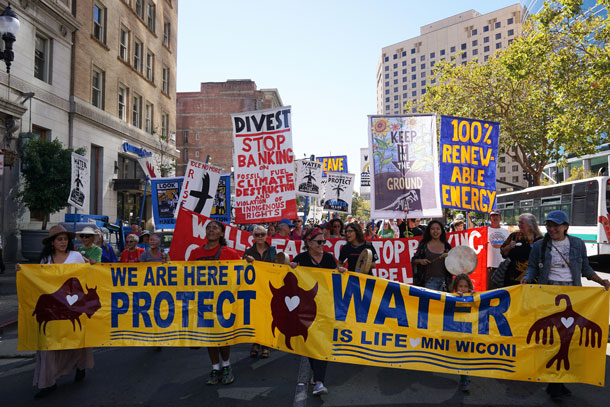
Protests over the Keystone XL and Dakota Access pipelines sparked a series of state laws to penalize protesters who interfere with fossil fuel infrastructure. (Photo: Jake Conroy, Rainforest Action Network, Flickr, CC BY-NC 2.0)
BASCOMB: Right. It's right there in the First Amendment, the right to peaceably assemble, I mean, seems like an open-and-shut case. Might other states follow South Dakota's lead here and relax their own penalties?
DYKSTRA: Well, some of the other states took the lead in enacting laws to crack down on protests. We'll see if the First Amendment argument and groups like the American Civil Liberties Union are able to turn those laws back as well.
BASCOMB: Mmhmm. Alright, well, what do you have for us from the history books this week?
DYKSTRA: October 31, 1984. A 35th anniversary of the Atlantic Striped Bass Conservation Act passed by Congress, back in the day when conservation measures were dealt with in a bipartisan way. It's led the way toward recovery. Striped bass, they're also known as rockfish. They're anadromous. They're found in freshwater, as well as salt water. They're generally considered "good eatin'", except in the Hudson River, where one of the worst PCB contamination hotspots still exists. There are tons and tons of striped bass in the Hudson, but you're not allowed to catch and eat because of the contamination factor.
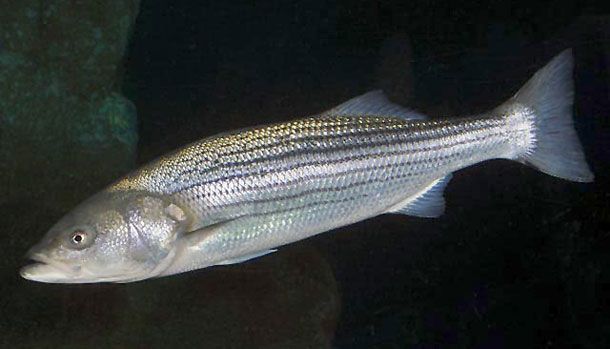
The Atlantic Striped Bass, also known as the rockfish in mid-Atlantic coastal communities. (Photo: D. Ross Robertson, Smithsonian Institution, Wikimedia Commons, Public Domain)
BASCOMB: Well, I mean, maybe that's another boon for the fish. If people aren't catching and eating them anymore, there's more to reproduce and improve their populations.
DYKSTRA: The population has bounced all the way back, as it has all along the range of the striped bass, up and down the Atlantic coast.
BASCOMB: Alright, well, that's encouraging. Peter Dykstra is an editor with Environmental Health News. That's EHN.org and DailyClimate.org. Thanks, Peter. We'll talk to you again soon.
DYKSTRA: All right, Bobby, thanks a lot. Talk to you soon.
Related links:
- The Conversation | “Americans, Especially Millennials, Are Embracing Plant-Based Meat Products”
- Inside Climate News | “South Dakota Backs Off Harsh New Protest Law and ‘Riot-Boosting’ Penalties”
- Read more on the legislation protecting the striped bass at the Striped Bass Magic website
[MUSIC: Taj Mahal, “Fishing Blues” on The Best Of Taj Mahal, traditional, Columbia Records]
CURWOOD: If you are in the Boston area next Tuesday, November 5, please join me and author Ian Urbina for a live event at the New England Aquarium. Ian will have stories from his new book, Outlaw Ocean, with its tales of courage, brutality and survival on the high seas, where lawlessness runs rampant. You can sign up for this free event on our website, loe.org or on our facebook page, PRI’s Living on Earth. And there’s a bonus. The first 75 pre-registered attendees will receive a free copy of the book. That’s Outlaw Ocean at the New England Aquarium Tuesday November 5th.
BASCOMB: Coming up – Research shows deforestation in the tropics can increase the prevalence of malaria cases. That’s just ahead on Living on Earth.
ANNOUNCER: Support for Living on Earth comes from Sailors for the Sea and Oceana. Helping boaters race clean, sail green and protect the seas they love. More information at sailors for the sea dot org.
[CUTAWAY MUSIC: A.B. Quintanilla, “Blanco y Negro” on Blanco y Negro, by A.B. Quintanilla III, Luigi Giraldo, Descemer Bueno, Universal Music Latin]
Note on Emerging Science: Deforestation and Malaria
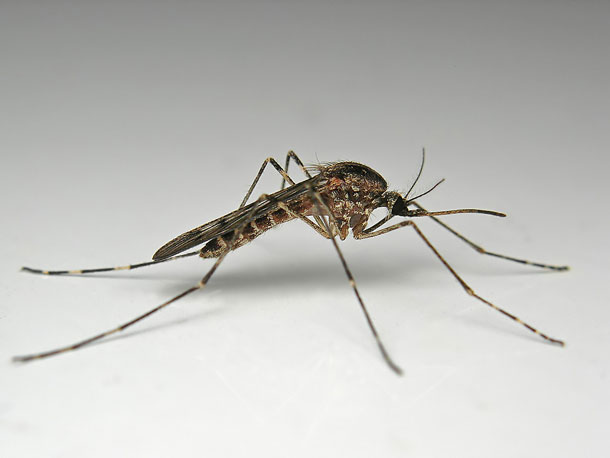
There are about 100 species of mosquito that can transmit human malaria. Mosquitos are responsible for more human deaths than any other animal on the planet. (Photo: Ryszard, Flickr, CC BY-NC 2.0)
BASCOMB: It’s Living on Earth I’m Bobby Bascomb.
CURWOOD: And I’m Steve Curwood.
Just ahead, a buyback of chainsaws to advance sustainable development in Borneo but first this note on emerging science from Don Lyman.
[SCIENCE NOTE THEME]
[MOSQUITO SOUND]
LYMAN: Mosquitoes have killed more people than any other animal in the world, mostly from malaria, and a new study finds rainforests that have been deforested have even higher rates of malaria than healthy forests.
Researchers from Stanford University analyzed 13 years of malaria occurrences from nearly 800 cities, towns and villages in the Brazilian Amazon. And they examined deforestation rates from the same time period.
The scientists found a 10 percent increase in deforestation led to an average 3.3 percent increase in malaria transmission. It may not sound like much but that means an additional 10,000 cases of malaria in some years.
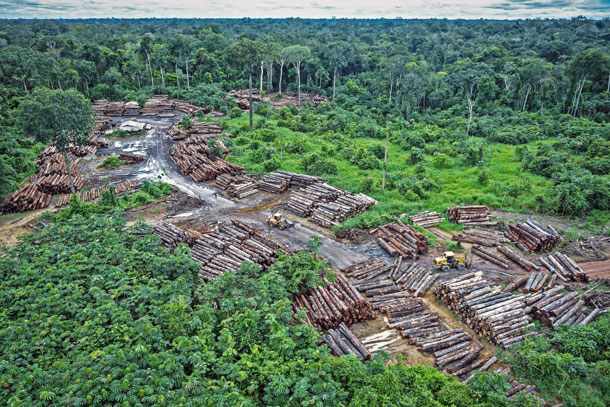
Deforestation in the Amazon has been linked to higher rates of malaria. (Photo: Felipe Werneck, Flickr, CC BY 2.0)
Researchers say the increase in malaria was greater in the interior Amazon, where small scale clearing for new settlements created more forest edge habitat, ideal mosquito breeding grounds. And of course, more breeding mosquitoes in settlement areas mean more people will be bitten by the malaria transmitting mosquitoes.
To minimize malaria transmission the researchers conclude that rainforest conservation should focus on the large, intact areas of the interior of the Amazon. So, a healthy rainforest can lead to healthier people.
That's this week's note on emerging science. I'm Don Lyman.
Related links:
- MongaBay | “Malaria Surges in Deforested Parts of the Amazon, Study Finds”
- Click here to read the study
Healthy People Equal Healthy Forests
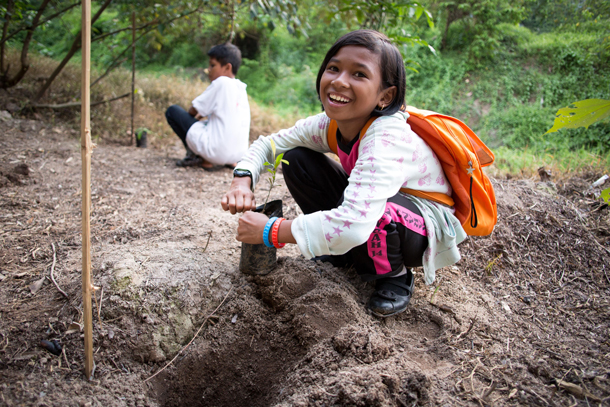
A young girl plants a seedling at the ASRI clinic in Gunung Palung National Park. (Photo: Chelsea Call)
[SFX SOUNDSCAPE FROM BORNEO UNDER LEAD]
BASCOMB: The rainforests of Borneo are some of the oldest tropical forests in world, roughly 130,000 years old. And because they evolved on an isolated island the forests are teeming with endemic species found nowhere else on earth. From highly endangered orangutans, tigers, and rhinos to pygmy elephants just five feet tall. Borneo’s Gunung Palung National Park is a critical habitat for many of the island’s endangered species and a huge carbon sink – crucial in our fight against climate change. The rainforest was also being deforested at an alarming rate when Kinari Webb first visited in the early 90’s. Kinari was a student at the time but she was so alarmed by the deforestation she saw that she went on to found the nonprofit Health in Harmony, which aims to keep the forest healthy by keeping people healthy and she joins me now to explain. Kinari Webb, welcome to Living on Earth!
WEBB: Thank you so much. It is such an honor to be here.
BASCOMB: So first of all, tell me about Gunung Palung National Park in Borneo and the relationship that these communities have with the forest there.
WEBB: So I first went to Borneo when I was an undergraduate. I took a year off and spent a year deep in the rainforest studying orangutans. And Gunung Palung National Park is considered the jewel in the crown of all the Indonesian national parks. It is just the most beautiful place I've ever been on Earth. And what's really interesting is that the communities surrounding the park, there's a lot of people who live right around the park, about 60,000 people. They love the forest as well. They consider it their mother and they understand that their well-being comes from the forest, because, largely because of water, but they also talk about, you know, if you go up into the forest and you log, you push disease down into the communities. And they understand kind of in a spiritual way too, if you log the forest, that might also make you sick just by disturbing the forest herself.
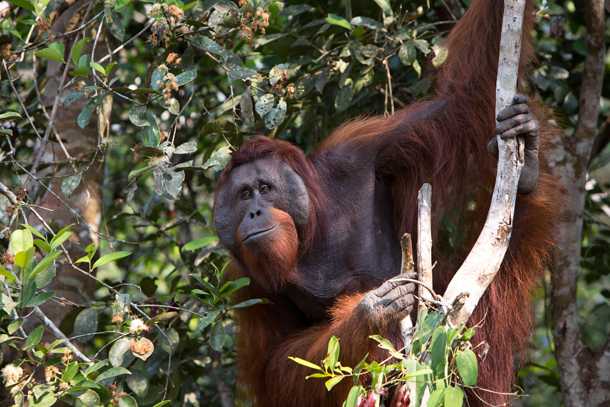
An orangutan in Indonesian Borneo. Kinari Webb was studying orangutans in Borneo in the early 1990s when she found out that much of the logging there was done so locals could cover health care costs. (Photo: Chelsea Call)
BASCOMB: And so how did you come to this idea of providing health care for people as a way to reduce deforestation?
WEBB: So what's really interesting is you look at this situation where the communities really love the forest, they honor and respect it, and they want it to be there for future generations. But the logging was rampant, it was completely out of control. And when I first went there, it was like the forest stretched to the horizon. And then it was just shrinking and you could hear the chainsaws all the time. And at first, I was just so angry at these people. But then I realized, and I talked to many of them, and what they told me was, you know, if my child is sick, or my family member is sick, I have no choice and it's one of the only ways to get cash. At another national park where we recently just started working, one woman told me, if anyone ever tells you that they have not logged to pay for health care, they are lying to you. Because there is no other way to get that much money, and one medical emergency can cost an entire year's income.
BASCOMB: Wow.
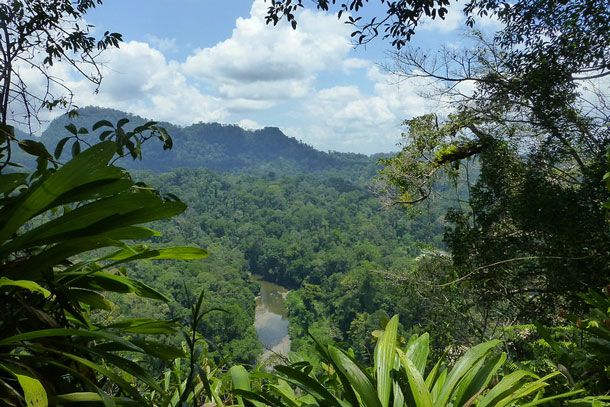
The forests of Indonesian Borneo. (Photo: Andy Nelson, Flickr CC BY-NC 2.0)
WEBB: So that just was like, that just broke my heart. How can that be? And how can we be allowing that to be? So I ended up going to medical school and returning to Indonesia so that I could try to work on this intersection between human and environmental health.
BASCOMB: You call it radical listening, the way that you discovered what these people need and how to help them. Can you tell me more about that?
WEBB: Yeah, you know, it's funny, I call it radical. The reason that I call it radical, even though it's truly just listening, is because we actually do what people say. And that is wildly unusual in the way that development is done and conservation is done. And it's sad that it's unusual, but it is very, very unusual. And so we just sit in a circle with a group of people, you know, about usually about 50 people, something like that. Men and women, leaders and just normal folks from the community. And we ask them, what would you all need as a thank you from the world community so that you could actually protect this precious forest that you all are guardians of? And it was amazing because every single community and everywhere we’ve been, it's been the same, that every community will independently come to a solution that is the same in a given region. So around Gunung Palung it was we need access to healthcare, and we need training and organic farming. And if we have those things, we can stop logging. Now, I just, in the beginning, I just trusted on faith that they truly knew what the solutions were. But 10 years later, we had incredible data that showed a 90% drop in logging households; a stabilization of the loss of primary forest, which had been shrinking like crazy. We had a re-growth, actually, of 52,000 acres of forest, and we had a 67% drop in infant mortality. So this was like this true win-win. And they knew the most efficient and effective ways so that they could do what they wanted to do, which was protect the forest.
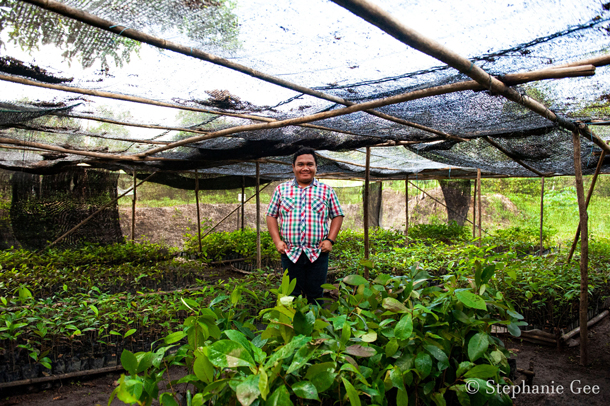
ASRI Director of Conservation Programs Dika stands in a seedling nursery. ASRI is the Indonesian sister nonprofit to Health in Harmony. (Photo: Stephanie Gee)
BASCOMB: It's amazing. I mean, it does ring true to me that, you know, I think a lot of NGOs will go to a community and say, Oh, you need a school, or you need a road. But if you actually stop and ask people, they might say, we need water. We need sanitation. And sounds like that's what you found there.
WEBB: Right? Yeah.
BASCOMB: Well, what kind of healthcare did people have there traditionally, and what does Health in Harmony provide?
WEBB: So when we first started in 2007 in these communities, there was a little government clinic; rarely had a doctor, and the system was not ideal, let's just say. So we ended up starting a little clinic, getting an ambulance, doing mobile clinics. We've now seen over 90,000 patient visits. We ended up providing a kind of simultaneous to the government healthcare system, when the government was struggling to get a system that was quite functional. And since then they have done a much, much better job. And we coordinate with them all the time, and I think that together, we have really made a great difference in these communities. And one of the heads of the Department of Health at one point said to me, he said, You know, I didn't even know it was possible to provide high quality health care in a remote area. It wasn't even trying until I saw your clinic.
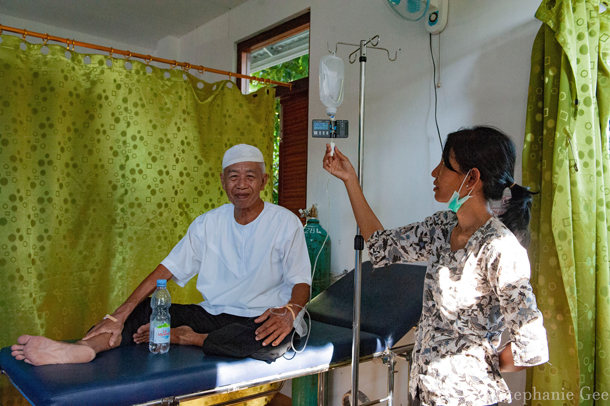
A patient is treated at the medical clinic at ASRI. (Photo: Stephanie Gee)
BASCOMB: And how do you make it affordable for people?
WEBB: So this is, this is sort of where it gets creative. We actually allow people to pay with non-cash payment options. We don't want anyone to ever have to log to pay for health care. So they can pay with seedlings; they can pay with manure, actually, that we use for the organic farming training; they can pay with labor. And these are very popular. Last year, we collected 18,000 seedlings from patients. But we also do another thing, which is that we give community-wide discounts to villages that are based on the amount of logging. So no logging at all, and they get a 70% discount in the clinic. And that discount is paid for by folks from all around the world, people like you, who want to say thank you to them for protecting this precious rainforest that's incredibly valuable to the whole world.
BASCOMB: And I saw your TED talk, you talk about taking American doctors who just want to give back or have an experience working in the developing world, to train your doctors there in Indonesia, or you take experts in agriculture from other parts of Indonesia and bring them to Borneo and do training there on the ground. Can you tell me how those partnerships work?
WEBB: Yeah, so like, I sometimes joke that what is needed in one place in the world just happens to be excess and another place in the world. So the communities needed, you know, and this is what they said, that we need high quality healthcare. So we hired young doctors from Indonesia who had just recently finished medical school, and then we trained them with doctors from the US who would come in free of charge loving this experience, getting to come, see the rainforest, and teaching and of course learning from these young doctors as well. And so that's been very successful. And then when we needed experts in organic farming, the next door island of Java has a many thousand year tradition in sustainable agriculture. So it was easy for us to bring in folks.
BASCOMB: And that's something that people told you that they wanted, was more training in organic farming. Can you tell me about that?
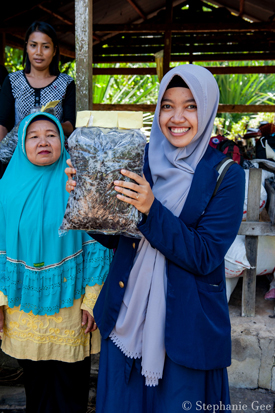
Members of the community are trained in organic and sustainable farming. (Photo: Stephanie Gee)
WEBB: Yeah, it's like so weird, right? I was very, very surprised when people asked for that. I thought, why don't you just talk to your grandparents? But they said no, no, the traditional form of agriculture here is slash and burn, right. And, and so they had some wet rice fields, because they had, they said, look, that system just isn't working anymore, there used to be so much forest and not many people. And it's just not like that anymore. So they said we know that we have to plant in one place, but the only way we know how to do that is with very expensive chemical fertilizers and we just can't afford them. And what was really interesting is that in our five year anniversary party, one of the village chiefs said that many of the former loggers had now become farmers because they didn't need startup money for chemical fertilizers, they could just make their own fertilizer. And, you know, that was one of those sort of like multi layers of why they asked for that solution that, as an outsider I would have never seen.
BASCOMB: And so what were your results? What was the rate of deforestation before you started this program and what is it today?
WEBB: So we started with about 1,350 logging households based on a baseline survey, and then after five years that went down to 450. And then after 10 years, it was down to 150 loggers. That's a 90% drop.
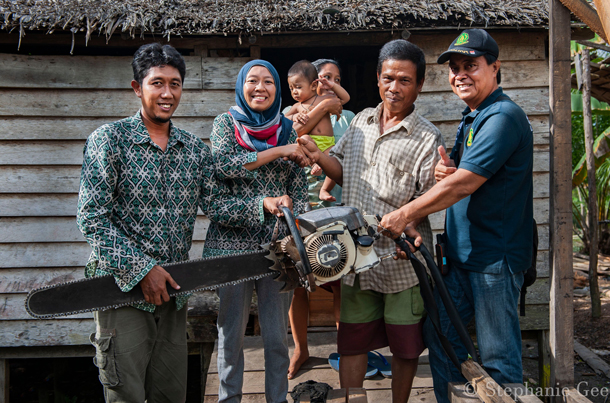
Local Pat Karim sells his chainsaw as part of the Chainsaw Buyback Program, wherein Health In Harmony buys and retires the chainsaws of local loggers and supports them in development of alternate forms of occupation. (Photo: Stephanie Gee)
BASCOMB: Wow.
WEBB: Now, since then, it's actually gone down even more because those last remaining 150 loggers, they are kind of the hardcore folks. They tended to be people who didn't own their own land, which is very unusual in that region. And they tended to own their own chainsaws, which is a huge, huge investment. So we actually started this program called a chainsaw buyback, where it's kind of like angel investing. We give them some money to start a small business, and they also put in money, but the money that they put in is their chainsaw, which we buy from them. And then they started these small businesses, which have been wildly successful. And I think it's mostly because people just didn't have the startup money. I talked to one guy who started a little chicken business, and in his community of 10,000 people, they were actually traveling 45 minutes to the nearest place where you could buy a chicken, right? That's like driving from New Haven to New York City to buy a chicken, that's the closest place you can buy chicken, right. And so I thought, Why has no one ever started a chicken business here before? And then I realized, of course no one has the $800 startup money. So, you know, with a little bit of investment people can start very successful businesses.
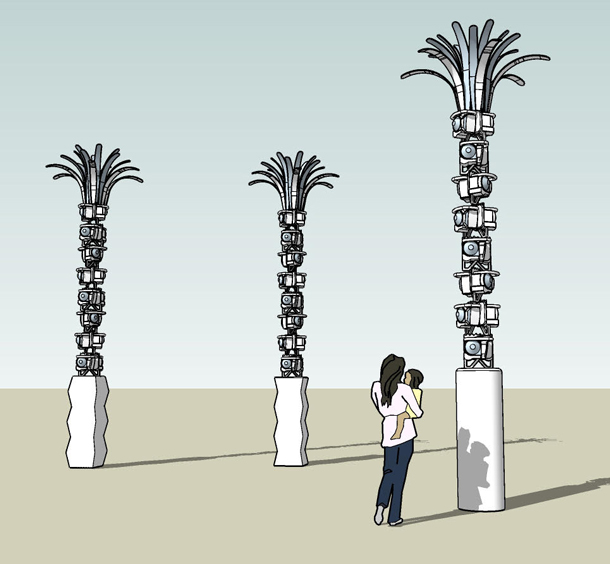
An illustration of what the chainsaw art will look like when completed. (Photo: courtesy of Health in Harmony)
BASCOMB: And what are you doing with all of those chainsaws that you bought?
WEBB: [LAUGHS] Yeah, we're actually, we have an amazing artist who has designed these sculptures, which will look like coconut palms, where we bend the blades, because these blades are very long. These are for cutting down giant, giant rainforest trees. And so we're going to put one in the courtyard of our medical center, and we're going to put one at the national parks office, and we're going to put one at the local university that we partner with, so we're excited about it.
BASCOMB: Oh, that's great. I love it. And what about the health improvements that you've seen?

A baby awaits immunization at the ASRI clinic. Infant mortality in the Gunung Palung area has dropped by nearly 70% since Health in Harmony and ASRI started working there in 2007. (Photo: Stephanie Gee)
WEBB: Yeah, so across the board, people are much, much healthier. You know, one of the very, very common reason for people to come into the clinic in the beginning was malaria. We actually in like the last six years haven't seen a single local case of malaria. We have also seen much less diarrhea, I think there's more than a 50% drop. There was a very interesting paper that came out in Science, I think last year, or the year before, where they looked at forest cover all over the world in relation to diarrhea. And the more forest there is, the less diarrhea.
BASCOMB: Yeah, so keeping the forest healthy, you're also keeping the people healthy. And in lots of different ways, it sounds like.
WEBB: Exactly. So there's like this synergistic effect. One of our Board Chair members, Jo Whitehouse, likes to say, one plus one is 11. I think that's really true. And we've seen all these sort of knock on effects that were totally unexpected, like 42% more children finishing grade school. Now, I'm sure the government had something to do with that. But it's also people are better off, their children are not having to stay home and take care of sick parents. You know, there's just all these ways that, suddenly you can send your kids to school. And that's the first thing you want to do when everything is going better.
BASCOMB: Now, many of our listeners have probably heard about deforestation in Borneo and associate it with palm oil and monocultures, you know, pretty large corporations that are buying these products. To what extent do you see, you know, these large operations impacting the forest where you work there?
WEBB: So there is no question that these large companies are a problem. But what's really interesting, there was an article in Science last year that showed that actually in the tropics, 69% of the loss of carbon is just from degradation, which is to say, taking out trees, individual trees. This is small -- we call it small-scale logging, right, but it's not really small scale. Its enormous. So yes, without question, you know, we should be avoiding palm oil, we should be pressing for more sustainable agricultural techniques from these large companies. But if we are not also addressing the needs of individuals, who really don't want to destroy the forest, they just don't have a choice -- then we're missing the boat. And if we miss the boat on saving rainforests, it's game over. Even if the entire world went to alternative energies, but we lost our rainforests, there's no way that we could deal with climate change.
BASCOMB: Yeah.
WEBB: And we just did a study with Stanford, which was looking at national parks across Indonesia, that's going to come out hopefully soon. And what they found, by looking at satellite imagery, was that while logging was dramatically declining, at Gunung Palung, it was actually increasing in national parks across Indonesia. So you know, we're going to lose these forests. And what's so sad to me is that we're losing them not because the people around them want to destroy the forest. They very much want the forest to be there. They just don't really have a choice.
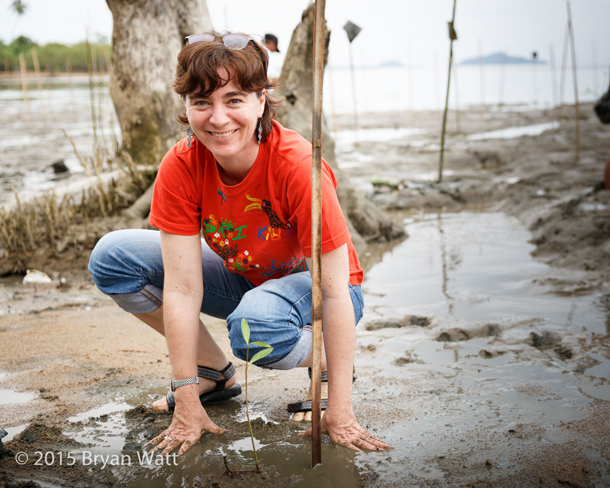
Kinari Webb. (Photo: Bryan Watt)
BASCOMB: And you're giving them a choice.
WEBB: Exactly. We're asking them what the solutions are, and then saying thank you from the world community.
BASCOMB: Kinari Webb is founder of the nonprofit organization Health in Harmony. Thank you so much for taking this time with me and for all of your good work.
WEBB: Thank you so much as well.
Related links:
- Health in Harmony website
- Dr. Kinari Webb’s TED talk about Health in Harmony
- Paper in Science (2017): Degradation and carbon loss from tropical forests
[MUSIC: Evergreen Studios “Gamelan”]
CURWOOD: Coming up –Catholic Bishops from the Amazon travel to Rome to meet with the Pope about deforestation and indigenous rights and call for women and married men to be allowed in church clergy. That’s just ahead on Living on Earth.
ANNOUNCER: Funding for Living on Earth comes from you, our listeners, and United Technologies, combining passion for science with engineering to create solutions designed for sustainability in aerospace, building industries, and food refrigeration. UTC companies such as Otis, Carrier, Pratt and Whitney, and UTC Aerospace systems are helping to move the world forward. You can learn more about United Technologies by tuning into the Race to Nine Billion podcast; listen at racetoninebillion.com. This is PRI, Public Radio International.
[CUTAWAY MUSIC: Dr. Michael White, “Give It Up” (Gypsy Second Line) on New Orleans by Michael G. White, Putumayo Records]
BirdNote®: Green Birds and Brown Birds in the Tropical Rainforest
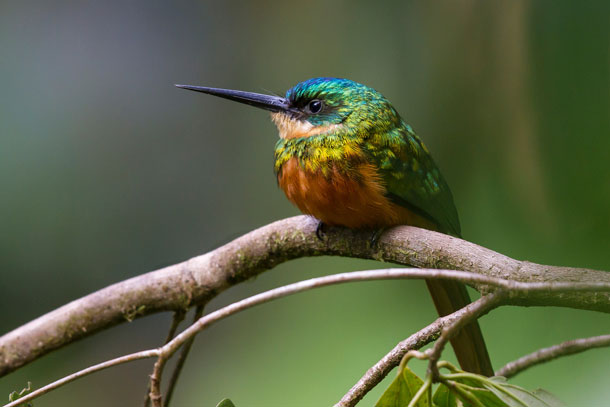
Rufous-tailed jacamars are striking in appearance with their iridescent, multicolored plumage. (Photo: Petr Kosina, CC)
CURWOOD: It’s Living on Earth, I’m Steve Curwood.
BASCOMB: And I’m Bobby Bascomb
[BIRDNOTE THEME]
Tropical rainforests are the most biodiverse terrestrial ecosystem on earth and home to some fifty percent of all the bird species in the world. Tropical birds have evolved a tremendous variety of adaptations, from intricate courtship rituals to massive horned bills for cracking nuts. But as BirdNote’s Michael Stein reports, most rainforests birds do have at least one thing in common.
BirdNote®
Green Birds and Brown Birds in the Tropical Rainforest
[Rainforest ambient]
STEIN: The canopies of the world’s tropical rainforests are green year round.
[Mealy Parrots, http://macaulaylibrary.org/audio/68674]
So are many of the birds within them, from mostly green parrots and sparkling, iridescent hummingbirds, to trogons [pronounced tro-gahnz] and jacamars [JAK-uh-mahrz], with their shiny green backs.
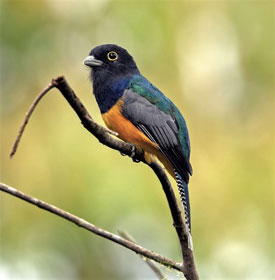
Male gartered trogons possess a yellow ring around their eyes that distinguishes them from other trogons. (Photo: Doug Greenberg, CC)
[Collared Trogon song, http://macaulaylibrary.org/audio/113241]
Their coloring underscores a fundamental of Darwinian evolution: “that an organism’s appearance, behavior and physiology must be adaptive to contribute to a greater overall level of reproductive success.” In other words, being green in the tropics means you won’t stand out and you have a better chance of reproducing, especially if you spend much of your time among the glossy leaves up top.
[Mealy Parrots, http://macaulaylibrary.org/audio/68674]
As for the vividly colorful birds found throughout the tropics, put them inside the forest, and their iridescent coloring becomes a dark disguise. Tropical birds that live in the shadows near the forest floor—antbirds, ovenbirds, and wrens—sport earth-tones of brown, gray, and black. Even the hummingbirds of the understory, known as hermits, wear drab plumage of gray, or brown, or only the dullest green. Camouflage almost as well suited for the deciduous forests of the north as the rainforests of the tropics.
I’m Michael Stein.
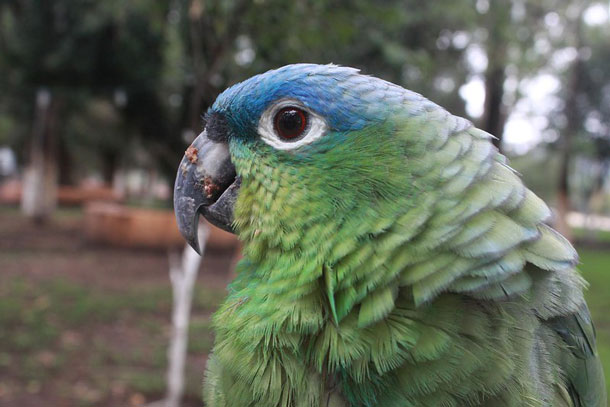
Although the mealy amazon parrot is not endangered, in some countries this bird is considered threatened due to habitat loss and the wildlife trade. (Photo: Terje Grimsgaard, CC)
Written by Bob Sundstrom
Bird sounds provided by The Macaulay Library of Natural Sounds at the Cornell Lab of Ornithology, Ithaca, New York. Mealy Parrots [68674] recorded by Paul A Schwartz; Collared Trogon recorded by Curtis A Marantz.
BirdNote’s theme music was composed and played by Nancy Rumbel and John Kessler.
Producer: John Kessler
Executive Producer: Dominic Black
© 2015 Tune In to Nature.org December 2015 Narrator: Michael Stein
https://www.birdnote.org/show/green-birds-and-brown-birds-tropical-rainforest
BASCOMB: For photos flock over to our website, loe dot org
[MUSIC: Carlos Moska, “Corcovado” on The Latin Jazz Collection, AML]
Related links:
- Learn more about this story on the BirdNote website
- Find out more about the rufous-tailed jacamar
- Learn more about the gartered trogon
- Discover more information about the mealy amazon parrot
Pope Hosts Amazon Synod
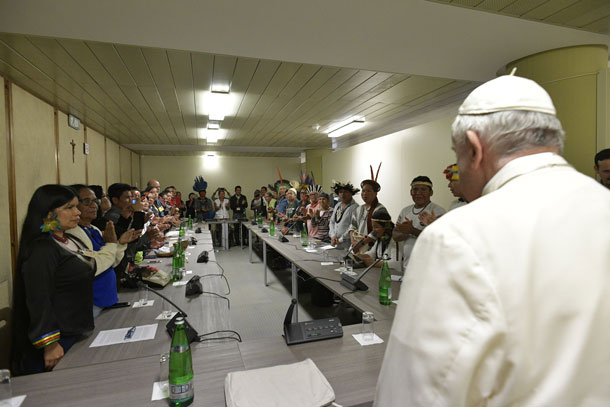
The Amazonian Synod united Catholic and indigenous leaders from the nine countries surrounding the Amazon Basin, Bolivia, Brazil, Colombia, Ecuador French Guiana, Guyana, Peru, Venezuela and Suriname. (Photo: Courtesy of Vatican Media)
CURWOOD: Pope Francis recently called the bishops of the Amazon to Rome for a council or Synod bringing bishops together with lay members of the indigenous community. High on the agenda were discussions about human rights, climate change and deforestation. And there is such an acute shortage of priests in Latin America, the synod ended up calling for allowing priests to marry and the ordination of women as deacons to have a more effective response to the Amazon crisis. Joining us now from Washington DC is Father Thomas Reese, Author of Inside the Vatican.
Father Reese welcome to Living on Earth!
REESE: Thank you Steve, good to be with you.
CURWOOD: So what were the major issues discussed at the Amazonian Synod?
REESE: Well, there were really three major issues that the Synod focused on. First was the incredible damage that's being done to the rain forest to the environment in the Amazon region. This is being done by economic interests that want to cut down the trees for lumber, and that want to clear forest for cattle ranches, that want to mine the precious minerals and oil that are in the Amazon region. And all of these economic interests are pushing for this and benefiting from it, but it's really not helping the people of the Amazon themselves. In fact, that's the second issue that the Synod was focused on, the violation of the human rights of the Amazonian people, of the indigenous people that lived there. Their land is being stolen from them. They are being driven out of their territories by criminal gangs. People who stand up to defend the rights of the Amazonian people are being murdered, are being killed. And finally, the bishops, well, they kind of realize that they need to update the way in which the gospel is being preached by the Catholic Church and how we are bringing the Gospel to the Amazon region. In the past, we really acted like colonial powers. We came in and tried to turn the Amazonian people into little Europeans, instead of allowing them to create a Catholic culture that reflected their own culture that reflected their own values, their own symbols, their way of worshiping, and so the bishops talked a lot about that how to have the Catholic Church “enculturated”, is the term they used, in the culture of the people of the Amazon. So those were the three big topics that they focused on.
CURWOOD: So this raises the question then, of who is leading the congregations, is leading the parishes there? A couple of different ways one, of course involves gender? I mean, typically when one goes to Latin America, one will find sisters pretty much running a parish. How did this come out of the Synod?
REESE: Well, you're absolutely right. This is an incredibly important question. Because many of these communities don't see a priest except once, twice a year. So there's nobody there to celebrate the Eucharist, there's nobody there to hear confessions, there's nobody there to anoint the sick, or do any of these kinds of things. So in these places that don't have priests, what happens? Well, the lay people step forward to be the leaders in the community and most of the time, frankly, it's lay women who step forward to teach the children about their faith, to lead discussions of the gospel of the Scripture. So, there is this great need for priests. The Catholic Church has to decide which is more important: having the Eucharist in the Christian community, in the Catholic community in the Amazon, or having a celibate priesthood. Because there simply are not enough people stepping forward, who are willing to live a celibate life as priests. So the bishops at the synod recommended that the Pope allow men of proven virtue that are married, to be ordained as priests so that they can serve these communities. And the Pope, he has a commission that he appointed already to study the possibility of having women deacons. This is the first time in almost 1000 years in which a church entity like a synod has made this kind of a recommendation. So we're hoping that the pope will listen to this and respond to it.
CURWOOD: Talk to me about the next steps. I gather there's some kind of a council that has been put together to implement what the Synod is talking about.
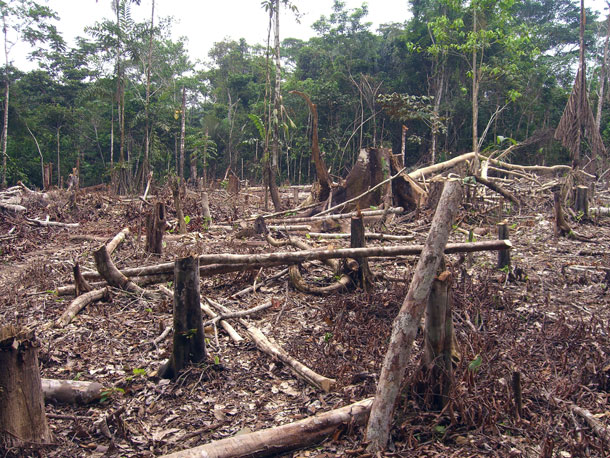
Deforestation, including aggressive slash-and-burn, has destroyed nearly one-fifth of the Amazon rainforest. (Photo: Matt Zimmerman, Flickr, CC By 2.0)
REESE: The Pope made very clear that the synod is not the end of the process. It's part of the process. He wants this to continue first of all down in the Amazon itself, with the bishops, consulting with their people, listening to their people. The synod established a synodal Council. This is to help the Pope in his response, and the Pope said that he hopes to respond to what the synod said before the end of the year. So that's, it’s not a piece of paper. That's the most important thing. You know, the last thing we need is another piece of paper, what we need now are actions, actions that people can take to preserve the environment. For example, one of the points they made very strongly was, you know that the people in the Western world, the people in the development world, and by that they meant Europe, America, North America, China and Japan, that people there have to change their lifestyles. They have to start eating less meat, they have to stop, you know, consuming all of the lumber that comes out of the Amazon. They have to stop lusting for the gold and the precious minerals that are coming out of the Amazon, because the Amazonian people cannot save the forest on their own, unless the lifestyles of the people in the development world and that means people listening to this program. Unless that changes, we're headed towards disaster of apocalyptic proportions.
CURWOOD: There's the question of these murders of people who are protecting the environment the rain forest, communities there in the Amazon. How does the Catholic Church propose fighting these murders?
REESE: Well, this is something that the bishops were very concerned about. Because remember, these bishops are from the Amazon region itself. So they're talking about personal experience. They've seen the destruction of the Amazon forest, and they've seen the killing of their people who have stood up for their rights. In fact, at the Amazon Synod, they had a lay woman whose husband had been murdered, for standing up for his rights. So the bishops are very concerned about this. And what are they going to do? They're going to speak out, they're going to raise a prophetic voice saying that the killing must stop, the stealing of indigenous territories must stop. They are forming lobby groups where they can speak with one voice on the international level condemning this and on the national level in their own countries, and they're demanding that the Brazilian government fully fund the operations they have for investigating these kinds of abuses. You know, they, they just simply have not put the resources into tracking down the murderers, or in protecting the rain forests. And of course, it's even worse under the current president who wants to continue chopping down the rain forest and exploiting its resources.
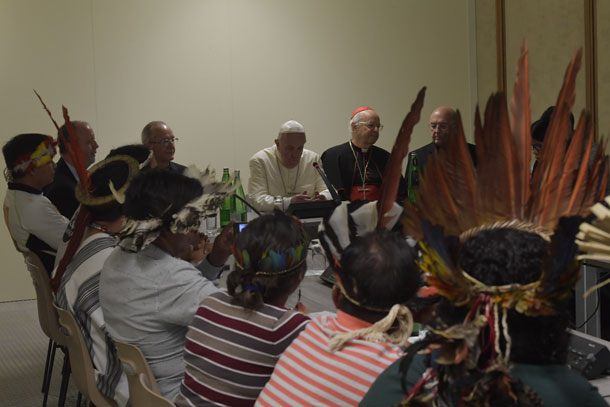
The closing document from the Amazon synod, the Instrumentum Laboris, touches on issues of colonialism, ecology and environmentalism, syncretism of Catholicism with indigenous tradition, amongst other themes. (Photo: Courtesy of Vatican Media)
CURWOOD: What about the conditions for the indigenous women in the Amazon? I understand that they’re in a lot of risk.
REESE: Yeah, I mean, it's always women and children who suffer the most when there is this kind of exploitation. Basically, what has happened is economic interests have chased these people either deeper into the jungles, or they have forced them to migrate to cities where they have hardly any opportunities. Sometimes they don't even know the local language. They don't know Spanish or Portuguese. Sometimes they come in there, they don't have education. And so they're really subject to exploitation to trafficking, both sex trafficking and for domestic servitude. So it's really, really sad. And it's, it's tragic.
CURWOOD: Let me ask you about Jair Bolsonaro, the president of Brazil, who has taken many steps to marginalize indigenous groups even more than they are and to push for further development in the Amazon in the agricultural type. To what extent is the pope communicating with President Bolsonaro, about deforestation and indigenous rights?
REESE: Oh, the Pope is obviously, has been very clear about this, the importance of protecting indigenous rights and the importance of protecting the environment. I mean, he's been really strong on this since his Encyclical Laudato si’, which talked about protecting the environment and protecting the indigenous peoples. So he's been very vocal on this. The bishops in the Amazon region have also. But the president of Brazil has been attacking the Synod of Bishops on the Amazon and he's been in fact trying to marginalize the Bishops who are speaking out against them. He sees them as opposing his policies. But the bishops are not going to stop speaking out about this.
CURWOOD: To what extent is President Bolsonaro tarring the church with the brush of, you know, liberation theology? These are radicals who are trying to usurp civilian authority.
REESE: Well, this is out of an old playbook that opponents of the Bishops have used frequently whenever the bishops speak out for the poor, whenever they defend indigenous people, they're immediately accused of being Marxists and communists. I mean, this has been going on for decades in Latin America, attacking people. But in reality, this is from The Scriptures, this is straight out of the Hebrew Prophets. This is straight from Jesus. You know, Jesus in Matthew:25 is asking people at the Last Judgment, did you feed the hungry, give drink to the thirsty, did you protect the poor? These are the things that are essential to Catholicism, and the bishops are going to continue to speak out on these things even if they get tarred as being communists and leftists. There was one Bishop in Latin America who said, you know, when I feed the poor, everybody says, I'm a saint. When I speak out on their behalf, they call me a communist.
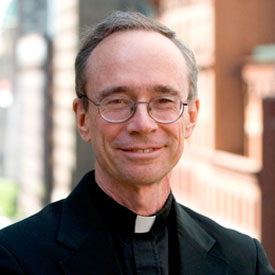
Father Thomas Reese, author of Inside the Vatican. (Photo: Courtesy of Father Reese)
CURWOOD: What role did environmental scientists play in this conversation?
REESE: What the bishops did is they listened, they listened to the scientists and what they are predicting in terms of global warming. They brought scientists to the synod. And you know, what they heard was concern that if the rain forest continues to be cut down, there's a tipping point, and nobody’s sure whether it's at 20% or 25%. But at some point, if so much of the rain forest is cut down, that the entire rain forest is going to die. And if that happens, it will have an incredible impact on the climate and the environment of the entire world. If climate change and global warming continues, we're going to see the oceans rise, we're going to see islands and their populations disappear. We're going to see Bangladesh underwater, we're going to see millions of people die and millions and millions of people become climate refugees. This is what we are going to hand on to our grandchildren and great grandchildren in the future. And the bishops are standing up not just for the indigenous people. They're standing up for future generations.
CURWOOD: Father Thomas Reese is a Senior Analyst for the Religion News Service. Thanks so much for taking the time with us today.
REESE: Good to be with you. Thank you.
Related links:
- Father Thomas Reese’s profile from National Catholic Reporter
- Special Assembly of the Synod of Bishops for the Pan Amazonian | “Amazonia: New Paths for the Church and for an Integral Ecology”
- Earthbeat | “Bishops Vote for Married Priests, Call Developed World to Repent for Harming Amazon”
- Full English Text of Amazon Synod’s Final Document
[MUSIC: Carlos Gilberto, “Favella” on The Latin Jazz Collection, AML]
CURWOOD: Living on Earth is produced by the World Media Foundation. Our crew includes Naomi Arenberg, Paloma Beltran, Thurston Briscoe, Jenni Doering, Jay Feinstein, Merlin Haxhiymeri, Don Lyman, Lizz Malloy, Aynsley O’Neill, Jake Rego, and Jolanda Omari.
BASCOMB: Tom Tiger engineered our show. Alison Lirish Dean composed our themes. You can hear us anytime at L-O-E dot org, iTunes and Google play- and like us, please, on our Facebook page - PRI’s Living on Earth. We tweet from @livingonearth. And find us on Instagram at livingonearthradio. I’m Bobby Bascomb.
CURWOOD: And I’m Steve Curwood. Thanks for listening!
ANNOUNCER: Funding for Living on Earth comes from you, our listeners, and from the University of Massachusetts, Boston, in association with its School for the Environment, developing the next generation of environmental leaders. And from the Grantham Foundation for the protection of the environment, supporting strategic communications and collaboration in solving the world’s most pressing environmental problems. Support also comes from the Energy Foundation, serving the public interest by helping to build a strong, clean, energy economy.
ANNOUNCER 2: PRI, Public Radio International.
Living on Earth wants to hear from you!
Living on Earth
62 Calef Highway, Suite 212
Lee, NH 03861
Telephone: 617-287-4121
E-mail: comments@loe.org
Newsletter [Click here]
Donate to Living on Earth!
Living on Earth is an independent media program and relies entirely on contributions from listeners and institutions supporting public service. Please donate now to preserve an independent environmental voice.
NewsletterLiving on Earth offers a weekly delivery of the show's rundown to your mailbox. Sign up for our newsletter today!
 Sailors For The Sea: Be the change you want to sea.
Sailors For The Sea: Be the change you want to sea.
 The Grantham Foundation for the Protection of the Environment: Committed to protecting and improving the health of the global environment.
The Grantham Foundation for the Protection of the Environment: Committed to protecting and improving the health of the global environment.
 Contribute to Living on Earth and receive, as our gift to you, an archival print of one of Mark Seth Lender's extraordinary wildlife photographs. Follow the link to see Mark's current collection of photographs.
Contribute to Living on Earth and receive, as our gift to you, an archival print of one of Mark Seth Lender's extraordinary wildlife photographs. Follow the link to see Mark's current collection of photographs.
 Buy a signed copy of Mark Seth Lender's book Smeagull the Seagull & support Living on Earth
Buy a signed copy of Mark Seth Lender's book Smeagull the Seagull & support Living on Earth

